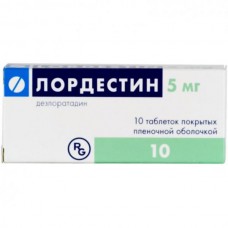Expiration date: 02/2026
The composition and form of issue:
Tablets, film-coated 1 tablet contains active substance:
of the 5,788 desloratadine hemisulfate mg
(that corresponds to the content of desloratadine 5 mg)
auxiliary substances: microcrystalline cellulose calcium hydrogen phosphate dihydrate starch pregelatinized silicon dioxide colloidal (Aerosil) magnesium stearate yellow Opadry AMV 80W22099 (polyvinyl alcohol partially hydrolyzed, titanium dioxide, talc, lecithin, aluminum lacquer dye quinoline yellow, xanthan gum, iron oxide yellow, aluminum lacquer based Indigo dye)
in blisters of PVC/PE/PVDC/aluminium foil for 10 PCs the paper cartons 1, or 3 blisters.
Description pharmaceutical form:
Round biconvex tablets, film-coated yellow color. Kind of on a break — white or almost white.
Pharmacokinetics:
Suction
After taking the drug inside the desloratadine is well absorbed from the gastrointestinal tract, with the designated concentrations of desloratadine in blood plasma are reached within 30 min After receiving a single dose of 5 or 7.5 mg Cmax is achieved in approximately 3 hours (2-6 hours). The bioavailability of desloratadine is proportional to dose (dose range 5-20 mg).
Distribution
The binding of desloratadine plasma protein is 83-87%, and 3-hydroxydesloratadine — 85-89%. When used in a dose of from 5 to 20 mg 1 time per day for 14 days evidence of clinically relevant accumulation of desloratadine not identified. Simultaneous food intake or simultaneous use of grapefruit juice does not affect biodostupnostthew and distribution of desloratadine (when taken in the dose of 7.5 mg 1 time a day). It permeates through the GEB.
Metabolism and excretion
Subjected to intensive metabolism in the liver to 3-hydroxydesloratadine, which is then glukuronidiruetsa. The main route of metabolism of desloratadine — hydroxylation. Is not an inhibitor of isoenzymes CYP3A4 and CYP2D6 and is a substrate or inhibitor of P-glycoprotein. Desloratadine is excreted as glucuronide compounds and a small amount of unchanged (renal — <2% and through the intestines — <7%). T1/2 of desloratadine and 3-hydroxydesloratadine is 20-30 hours (average 27 hours).
Chronic renal failure (CRF). Cmax and AUC of desloratadine increase from 1.2 to 1.7 times from 1.9 to 2.5 times, respectively (compared with healthy volunteers). Concentration of 3-hydroxydesloratadine varies slightly. The binding of desloratadine and 3-hydroxydesloratadine with plasma proteins in chronic renal failure does not change. Desloratadine and 3-hydroxydesloratadine poorly removed by hemodialysis.
Liver failure. In patients with hepatic impairment AUC increased 2.4-fold compared with healthy volunteers. Total clearance of desloratadine in oral administration in patients with mild, moderate, and severe hepatic insufficiency is 37, 36 and 28%, respectively (compared with healthy volunteers). The increase in T1/2 of desloratadine in patients with hepatic insufficiency.
Cmax and AUC of 3-hydroxydesloratadine in patients with hepatic insufficiency do not differ from data of healthy people with normal liver function.
Description pharmacological action:
Blocker of H1-histamine receptors, is the primary active metabolite of loratadine. Inhibits the release of histamine and of leukotriene C4 from mast cells. Warn development and facilitates the allergic reactions. It has antiallergic, antipruritic and protivoekssoudative action. Reduces the permeability of capillaries, prevents the development of tissue edema. Almost has no sedative effect and when taken in therapeutic doses does not affect the speed of psychomotor reactions.
Indications:
- seasonal allergic rhinitis (for the relief of the following symptoms: sneezing, rhinorrhea, itching, nasal congestion, itchy eyes, watery eyes, eye redness and itching in the palate, cough)
- chronic idiopathic urticaria (itching and rash).
Contraindications:
- pregnancy
- lactation
- hypersensitivity to the drug
- children up to age 12 years.
With caution: severe renal insufficiency.
Application of pregnancy and breast-feeding:
The drug is contraindicated in pregnancy.
As desloratadine is excreted in breast milk, the use of the drug during lactation (breastfeeding) contraindicated.
Side effects:
The most common adverse effects: 12% fatigue 8% — dry mouth and 0.6% headache.
Side effects according post-marketing studies: dizziness, tachycardia, palpitations, abdominal pain, dyspepsia (including nausea, vomiting, diarrhea), hyperbilirubinemia, increased liver enzymes, hepatitis, allergic reactions (skin rash, itching, hives, angioedema, anaphylactic shock), dysmenorrhea, fatigue, myalgia, hallucinations, psychomotor hyperactivity, insomnia, drowsiness.
Drug interactions:
In a joint application with ketoconazole, erythromycin, azithromycin, fluoxetine and cimetidine clinically significant changes of concentration of desloratadine in the plasma is not revealed. Largestin does not increase the inhibitory effect of ethanol on psychomotor function.
Method of application and dose:
Inside.
Adults and adolescents aged 12 years and older the drug is prescribed 1 times a day in a dose of 5 mg (1 table.).
The drug recommended to take at the same time of day, regardless of meals, squeezed small amounts of water. The tablets should be swallowed whole without chewing.
In chronic renal failure and liver failure require correction of dosing regimen: initial dose of 5 mg is recommended to take in a day (according to pharmacokinetics). Recommendations on dosing in children with chronic renal failure and hepatic insufficiency are absent because of insufficient data.
Overdose:
In case of overdose marked drowsiness.
Treatment: gastric lavage, activated charcoal, symptomatic therapy. The drug is not removed by hemodialysis. Efficacy of peritoneal dialysis is not installed.
Precautions:
Effects on ability to drive or to perform work requiring high speed physical and mental reactions
There was no effect Nordestina when used in recommended doses on ability to drive vehicles and management mechanisms. However, given that patients may be drowsiness, caution should be used when side effects from the CNS.
Storage conditions:
Protect from high humidity.
Lordestin
(Desloratadine)
tablets
- Brand: Gedeon Richter



